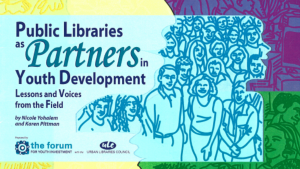
The pressure for comprehensiveness is on. Scores of states and localities have put in place intricate processes for crafting and implementing comprehensive strategies to improve child and youth outcomes. The White House convened a star-studded conference on Comprehensive Services. And individual agencies are knee-deep in discussion of what services are really needed to affect the outcomes for which they are accountable.
I have had the good fortune to be in quite a few of these meetings and I find myself repeating the same mantra: Effective programs offer more than services. If the goal is youth development (or family strengthening, or neighborhood development), then the strategies have to be broader than service provision. Services, opportunities, and supports are the S.O.S. for youth.
Consistently, this message rings home. Descriptions of youth employment and training programs, for example, were easily analyzed through this lens. Then most promising programs were those that balanced training and skill building with real job experiences with ongoing — pre and post-placement — guidance, feedback, and advocacy.
But the message has to be broadly delivered and broadly defined — the paradigm, in current jargon, has to be shifted. Years of defining the goal as problem reduction have created a bias toward strategies that are short term, formal and service-heavy. Introduced into this mind-set, comprehensive means more of the same.
Like the other “C”s — collaboration, cooperation, coordination — comprehensiveness is an overused term. Without a framework, discussions can veer off course quickly. Undefined, calls for comprehensiveness can create a bias towards breadth rather than depth of services, threatening quality. They can mean that fewer are served as more services are required. They can drive up costs without delivering results.
Case in point. Six or seven years ago, one-stop shopping programs were touted as the best way to address the multiple problems faced by adolescents. Comprehensive, for most, meant a full-service menu. The logic behind the idea was compelling: problems co-vary so services should be co-located. But the results were mixed. Absent a conscious reexamination of goals and assumptions, the idea was often reduced to a checklist.
Stretching the goal from prevention to development requires defining a set of desired outcomes that are positive, broad, and balanced. More positive that the “preventions,” broader and more balanced that the current focus on academic and vocational skills. Decision-making, leadership skills are needed as are a sense of responsibility and community commitment. And, much like the effect of looking through a wide-angled lens, broader outcomes lead naturally to broader definitions of strategies. Without effort, basic parameters for defining strategies emerge. It becomes clear that:
What is offered young people has to go well beyond services that provide instruction, care, and resources to opportunities that provide developmentally appropriate chances to learn, earn, explore, and contribute and supports that nurture and assist youth as they strategize to meet goals. Youth development requires a balance of these essential inputs.
Where young people get these inputs is not just in programs, and certainly not just in formal institution, but in families and neighborhoods. There is a natural ecology of community that needs to be respected and used. Programs and institutions can contribute to development, but they cannot control it — informal settings are critical.
When young people get these inputs is not just after the fact, but throughout their lives. When, also, cannot be just when others deem them necessary. Youth and families should be able to access S.O.S. as based on their assessments.
Who offers these inputs are not just professionals, or “found” volunteers, but community residents, neighbors, family, peers. The professionals that offer them have to be competent and caring.
How these inputs are offered is critical to whether they will be accepted and effective. They have to be available, affordable, and accessible — geographically and culturally. They have to be appropriate – relevant, realistic, and developmentally rigorous. They have to be acknowledging — respectful, rewarding, relationship-rich.
Of course, the key reporter’s question is always Why. Comprehensive services are an adequate answer if our goal is to find more cost-effective ways to repair damage and prevent problems. But comprehensive strategies to offer a full range of services, opportunities, and supports through a well-functioning network of individual, community and institutional providers are the answer if the goal is youth development. No more jargon. Let’s be comprehensive about defining what is needed.
We welcome your contributions to the topic. Please reach out to talkwithus@kpcatalysts.com if you’d like to join to the discussion.
Pittman, K. (1994, September/October). “S.O.S. for Youth.” Washington, DC: The Forum for Youth Investment. A version of this article appears in Youth Today. September 1, 1994




No comment yet, add your voice below!